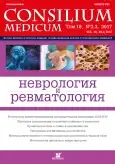Serum neuron-specific enolase and S-100 protein levels in children with some forms of symptomatic epilepsy as reflection of disregulative pathology of central nervous system
- Authors: Pugolovkin K.A1, Dombrovskaya E.A1
-
Affiliations:
- Russian Rehabilitation Center “Childhood”
- Issue: Vol 19, No 2-3 (2017)
- Pages: 23-27
- Section: Articles
- URL: https://journals.rcsi.science/2075-1753/article/view/94687
- ID: 94687
Cite item
Full Text
Abstract
Full Text
##article.viewOnOriginalSite##About the authors
K. A Pugolovkin
Russian Rehabilitation Center “Childhood”
Email: pkirill-msk@mail.ru
врач-невролог, зав. психоневрологическим отд-нием 142031, Russian Federation, Moscow region, pos. sanatoriia “Gorki Leninskie”
E. A Dombrovskaya
Russian Rehabilitation Center “Childhood”рач-невролог психоневрологического отд-ния 142031, Russian Federation, Moscow region, pos. sanatoriia “Gorki Leninskie”
References
- Карлов В.А. Судорожный эпилептический статус. М.: МЕДпрессинфо, 2003.
- Карлов В.А. Эпилепсия. М.: Медицина, 1990.
- Commission of ILAE, 1989 Commission on Classification and Terminology of the International League Against Epilepsy, Proposal for revised classification of epilepsies and epileptic syndromes. Epilepsia 1989; 30: 389-99.
- Дизрегуляционная патология нервной системы. Под ред. Е.И.Гусева, Г.Н.Крыжановского. М.: МИА, 2009.
- Мотавкин П.А., Черток В.М. Гистофизиология сосудистых механизмов мозгового кровообращения. М.: Медицина, 1980
- Крыжановский Г.Н. Дизрегуляционная патология. Патогенез. 2004; 2 (1).
- Guekht A, Gusev E, Shpak A. et al. Evoked potentials and brain plasticity in patients with localization-related epilepsy. Epilepsia 2001; 42 (Suppl. 2).
- LaRoshe S.M, Helmers S.L. Epilepsy in the elderly. Neurologist 2003; 9 (5).
- Dong W.K, Greenough W.T. Plasticity of nonneuronal brain tissue: roles in developmental disorders. Ment Retard Dev Disabil Res Rev 2004; 10 (2).
- Штарк М.Б. Мозгоспецифические антитела и функции нейронов. М.: Медицина, 1985
- Полетаев А.Б. Мозгоспецифические белки группы S-100, их эндогенные акцепторы и лиганды и регуляция метаболических процессов в нервной ткани. Автореф. дис. … д-ра мед. наук. М., 1988
- Зиньковский К.А., Яковлев Н.А., Морозов С.Г. Особенности клинико-иммунологических отношений при эпилепсии. Нейроиммунология. 2005; 3 (2
- Громов С.А., Липатова Л.В. Диагностика клинико-нейроиммунологических нарушений у больных эпилепсией с синдромом энцефалопатии, их иммунокоррекция и лечение. Методические рекомендации. СПб.: НИИПНИ им. В.М.Бехтерева, 2010.
- Gurnett C.A, Landt M, Wong M. Analysis of cerebrospinal fluid glial fibrillary acidic protein after seizures in children. Epilepsia 2003; 44 (11).
- Giardi E, Ramos A.J, Vanore G, Brusco A. Astrocytic response in hippocampus and cerebral cortex in an experimental epilepsy model. Neurochem Res 2004; 29 (2).
- Карякина Г.М., Надеждина М.В., Хинко М.А. Нейронспецифическая енолаза как индикатор поражения мозговой ткани при ишемическом инсульте. Неврологический вестн. 2007; 39 (Вып. 1).
- Рахимбаева Г.С., Рашидова Н.С. Нейронспецифическая енолаза в сыворотке крови как диагностический маркер эпилепсии. Междунар. неврологический журн. 2011; 2 (40).
- Галиева Г.Ю., Попонникова Т.В., Вавин Г.В. Нейронспецифическая енолаза и белок NS-100 как возможные маркеры поражения нервной системы при острых клещевых нейроинфекциях у детей. Сиб. мед. журн. 2008; 7.
- Palmio J, Peltola J, Vuorinen P. et al. Normal CSF neuron-specific enolase and S-100 protein levels in pacients with recent non-complicated tonic-clonic seizures. J Neurol Sci 2001; 183 (1).
- Leutmezer F, Wagner O, Baumgartner C. Serum S-100 pritein is not a suitable seizure market in temporal lobe epilepsy. J Epilepsia 2002; 43 (10): 1172-4.
- Palmio J, Keranen T, Alapirtti T. et al. Elevated serum neuron-specific enolase in patients with temporal lobe epilepsy: a video-EEG study. J Epilepsia 2008; 81 (2-3): 155-60.
- Tumani H, Otto M, Gefeller O. et al. Kinetics of serum neuron-specific enolase and prolactin in patients after single epileptic seizures. J Epilepsia 1999; 40 (6): 713-8.
Supplementary files






